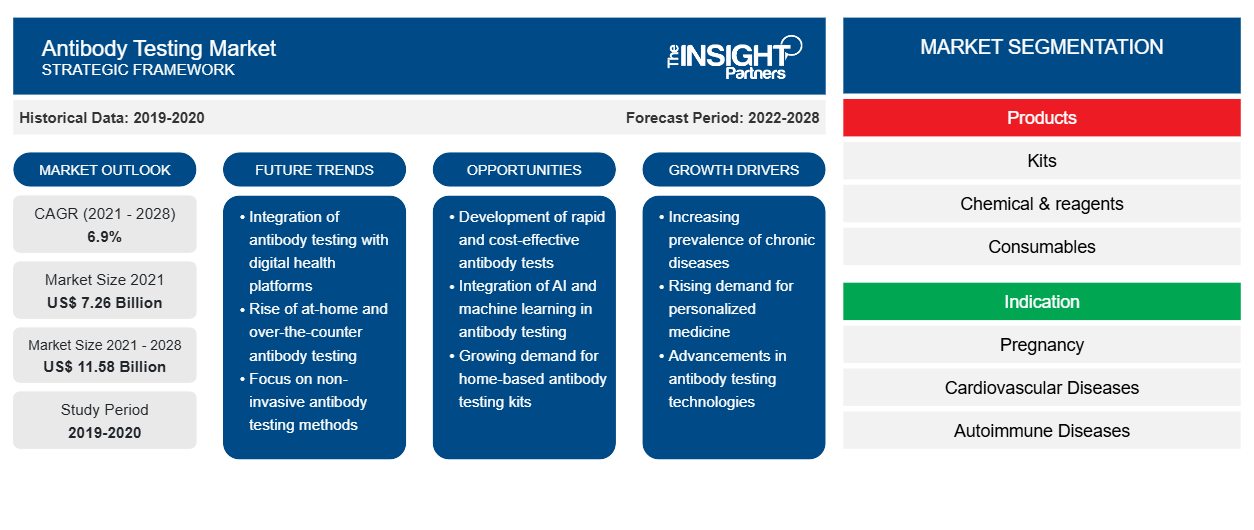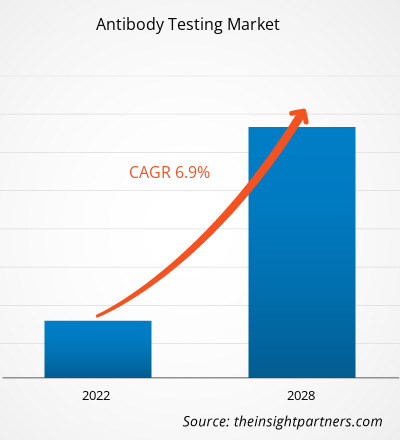2021 年抗体检测市场价值为 72.6 亿美元,预计到 2028 年将达到 115.7847 亿美元;预计 2021 年至 2028 年的复合年增长率为 6.9%。
抗体是免疫球蛋白,是一种由免疫系统产生的 Y 形蛋白质,可阻止入侵者伤害身体。抗体测试是对血液中抗体的筛查。人体在对抗 COVID-19 等感染或患者接种疫苗时会产生抗体。这就是对病毒产生免疫力的方式。这些测试也称为血清学测试。抗体测试有助于诊断自身免疫性疾病或排除具有类似体征和症状的其他疾病。此外,抗核抗体 (ANA) 是一组自身抗体,当个体免疫系统无法充分区分“自身”和“外来”成分时,就会产生这种抗体。ANA 测试可检测血液中的抗体。ANA 与健康身体细胞的部分发生反应,并引起组织和器官炎症、关节和肌肉疼痛以及疲劳等症状。ANA 专门针对细胞核中的物质;因此这些抗体被称为“抗核抗体”。抗体检测试剂盒可预测 COVID-19 感染的预后和检测,以支持该疾病。全球范围内新冠病例数的不断增加、慢性病患病率的不断上升以及老年人口的不断增长推动了抗体检测市场的发展。此外,政府的支持力度不断加大,也推动了抗体检测的发展,进而影响了市场的发展。例如,美国食品药品监督管理局 (FDA) 公开分享了抗体或血清学检测试剂盒的检测性能数据。这些结果来自 FDA、NIH、疾病控制与预防中心 (CDC) 和生物医学高级研究与发展局 (BARDA) 的合作。
定制此报告以满足您的需求
您可以免费定制任何报告,包括本报告的部分内容、国家级分析、Excel 数据包,以及为初创企业和大学提供优惠和折扣
- 获取此报告的关键市场趋势。这个免费样品将包括数据分析,从市场趋势到估计和预测。
抗体检测市场的范围包括产品、适应症、最终用户和地理位置。抗体检测市场分析基于北美、欧洲、亚太、中东和非洲以及南美和中美等地区。该报告对抗体检测市场进行了深入分析,重点关注各种参数,例如市场趋势、技术进步、市场动态以及全球主要市场参与者的竞争格局分析。
市场洞察
全球新冠肺炎病例数量不断上升。
自从 2020 年 1 月底严重急性呼吸综合征冠状病毒 2 (SARS-CoV-2) 被宣布为国际关注的公共卫生紧急事件以来,医疗专业人员和研究人员一直在敦促对公民进行全面、快速的检测,以制定可以遏制病毒传播的措施。随着时间的推移,实时聚合酶链反应 chain reaction检测和抗体检测已成为全球医疗保健系统管理疫情的重要技术。抗体检测对于 SARS-CoV-2 的鉴别诊断至关重要。这是一项使用试剂红细胞通过患者血清或血浆进行的测试。确定病毒和细菌病原体和寄生虫的特异性抗体有助于采取正确的治疗措施。抗体检测对于实施有效和高效的公共卫生战略以最大限度地减少 COVID-19 大流行的不利影响至关重要。它应该在重要的临床应用案例中采用,并支持全球复工战略。
抗体检测试剂盒可预测 COVID-19 感染的预后和检测,从而帮助治疗疾病。由于这些试剂盒有助于检查一个人的血液中是否产生了对抗 SARS-CoV-2 的抗体,因此它可以表明一个人是否接触过或感染过 COVID-19。为了控制 COVID-19 大流行并增加患者筛查,多家公司正在向医护人员、医院、实验室和其他专业人员提供这些快速抗体检测试剂盒。因此,冠状病毒病例发病率的上升和政府对抗体检测试剂盒的批准不断增加是导致市场增长的几个因素。
基于产品的见解
根据产品,全球抗体检测市场分为试剂盒、化学品和试剂、消耗品。2021 年,试剂盒部分占据了市场的最大份额。该部分的增长归因于 Abbott、F. Hoffmann-La Roche Ltd、Bio-Rad Laboratories, Inc. 等大量制造商,以及各种研究过程中试剂盒的采用率更高。在预测期内,同一部分可能会在全球抗体检测市场中实现最高的复合年增长率。此外,试剂盒部分细分为血清学检测试剂盒、免疫球蛋白试剂盒和横向流动检测试剂盒。血清学检测试剂盒在 2021 年占据了最高的市场份额。
基于指示的见解
根据适应症,全球抗体检测市场分为妊娠、心血管疾病、自身免疫性疾病、传染病、肿瘤学、内分泌疾病等。传染病领域在 2021 年占据了最大的市场份额,预计同一领域在预测期内将实现最高的复合年增长率。
基于最终用户的洞察
根据最终用户,全球抗体检测市场分为医院、学术和研究机构、诊断实验室和生物制药公司。诊断实验室部门在 2021 年占据了最大的市场份额,预计同一部门在预测期内将实现最高的复合年增长率。
COVID-19 疫情已成为全球面临的最大挑战。这一挑战尤其令人担忧,因为全球贸易中断导致进口减少,这对全球发展中国家尤其如此。迄今为止,尚未建立针对 COVID 19 的明确治疗方法。因此,缺乏确定性治疗方法为抗体检测市场提供了重大机遇,因为美国 FDA 最近批准使用血浆疗法治疗重症 COVID 19 患者。从长远来看,抗体检测市场将具有巨大的增长前景,因为许多市场参与者已获得其新开发的抗体检测的紧急使用授权。所有这些发展都将增加对抗体检测市场的未来需求。
公司通常采用产品发布和扩张战略来扩大其全球业务范围并满足不断增长的需求。市场参与者通常采用这些策略来扩大其产品组合。
抗体检测市场的市场参与者采用产品创新策略来满足全球不断变化的客户需求,这也使参与者能够在全球范围内保持其品牌名称。
- 2021 年 2 月,安捷伦科技公司宣布推出安捷伦 Dako SARS-CoV-2 IgG 酶联免疫吸附测定 (ELISA) 试剂盒,用于定性检测人血清或血浆中 SARS-CoV-2 的免疫球蛋白 G (IgG) 抗体。该试剂盒标志着安捷伦进入美国 SARS-CoV-2 检测领域,已根据 FDA“公共卫生紧急事件期间冠状病毒病 2019 检测政策(修订版)”第 IV.D 条完成向 FDA 的通知程序。该检测试剂盒计划于 2021 年在其他市场注册,包括加拿大、欧洲以及部分亚太和拉丁美洲国家。
- 2020 年 4 月,雅培推出了一项血清学检测,用于检测 SARS CoV 2 的 IgG 抗体。这种新的抗体检测采用了雅培的 ARCHITECT i1000SR 和 i2000SR 实验室仪器,每小时可进行多达 100 到 200 次检测。
抗体检测——市场细分
抗体检测市场根据产品、适应症和最终用户进行细分。根据产品,抗体检测市场进一步细分为试剂盒、化学品和试剂以及消耗品。根据适应症,抗体检测市场进一步细分为妊娠、传染病、肿瘤学、心血管疾病、内分泌疾病、自身免疫性疾病和其他。根据最终用户,抗体检测市场进一步细分为医院、学术和研究机构、诊断实验室和生物制药公司。按地域划分,全球抗体检测市场细分为北美(美国、加拿大和墨西哥)、欧洲(法国、德国、英国、西班牙、意大利、希腊和欧洲其他地区)、亚太地区(中国、印度、日本、澳大利亚、韩国和亚太地区其他地区)、中东和非洲(沙特阿拉伯、阿联酋、南非和中东和非洲其他地区)以及南美洲和中美洲(巴西、阿根廷和南美其他地区)。
抗体检测市场区域洞察
Insight Partners 的分析师已详细解释了预测期内影响抗体检测市场的区域趋势和因素。本节还讨论了北美、欧洲、亚太地区、中东和非洲以及南美和中美洲的抗体检测市场细分和地理位置。

- 获取抗体检测市场的区域特定数据
抗体检测市场报告范围
| 报告属性 | 细节 |
|---|---|
| 2021 年市场规模 | 72.6亿美元 |
| 2028 年市场规模 | 115.8亿美元 |
| 全球复合年增长率(2021 - 2028) | 6.9% |
| 史料 | 2019-2020 |
| 预测期 | 2022-2028 |
| 涵盖的领域 | 按产品分类
|
| 覆盖地区和国家 | 北美
|
| 市场领导者和主要公司简介 |
|
抗体检测市场参与者密度:了解其对业务动态的影响
抗体检测市场正在快速增长,这得益于终端用户需求的不断增长,而这些需求又源于消费者偏好的不断变化、技术进步以及对产品优势的认识不断提高等因素。随着需求的增加,企业正在扩大其产品范围,进行创新以满足消费者的需求,并利用新兴趋势,从而进一步推动市场增长。
市场参与者密度是指在特定市场或行业内运营的企业或公司的分布情况。它表明相对于给定市场空间的规模或总市场价值,有多少竞争对手(市场参与者)存在于该市场空间中。
抗体检测市场的主要公司有:
- 赛默飞世尔科技
- 雅培实验室
- Bio-Rad 实验室有限公司
- 贝克顿·迪金森公司
- F. 霍夫曼拉罗歇
免责声明:上面列出的公司没有按照任何特定顺序排列。

- 了解抗体检测市场主要参与者概况
公司简介
- 赛默飞世尔科技
- 雅培实验室
- Bio-Rad 实验室有限公司
- 贝克顿·迪金森公司
- F. 霍夫曼拉罗歇
- 安捷伦科技
- 迪亚索林
- 宙斯科学
- 艾博抗
- 三一生物科技
- 历史分析(2 年)、基准年、预测(7 年)及复合年增长率
- PEST 和 SWOT 分析
- 市场规模价值/数量 - 全球、区域、国家
- 行业和竞争格局
- Excel 数据集


- EMC Testing Market
- Third Party Logistics Market
- Fishing Equipment Market
- Asset Integrity Management Market
- Quantitative Structure-Activity Relationship (QSAR) Market
- Smart Parking Market
- Bioremediation Technology and Services Market
- Medical Collagen Market
- Excimer & Femtosecond Ophthalmic Lasers Market
- Power Bank Market

Report Coverage
Revenue forecast, Company Analysis, Industry landscape, Growth factors, and Trends

Segment Covered
This text is related
to segments covered.

Regional Scope
North America, Europe, Asia Pacific, Middle East & Africa, South & Central America

Country Scope
This text is related
to country scope.
常见问题
The infectious diseases segment dominated the global antibody testing market and held the largest market share of 26.44% in 2021.
The diagnostic laboratories segment dominated the global antibody testing market and held the largest market share of 41.58% in 2021.
The antibody testing market majorly consists of the players such as Thermo Fisher Scientific, Abbott Laboratories, Bio-Rad Laboratories, Inc., Beckton, Dickinson And Company, F. Hoffmann La Roche, Agilent Technologies, DiaSorin, Zeus Scientific, ABCAM, Trinity Biotech and among others.
The kits segment dominated the global antibody testing market and held the largest market share of 54.08% in 2021.
An antibody test is a screening for the presence of antibodies in the blood. The body makes antibodies when it fights infection, like COVID-19 or when patients get a vaccine, like a flu shot. That’s how immunity to a virus is built. These tests are also called serology tests. Antibody tests help diagnose an autoimmune disease or rule out other conditions with similar signs and symptoms. Antibody detection kits are predictive of prognosis and detection of COVID-19 infection to support the disease. The antibody testing market is driven by a rising number of COVID-19 cases worldwide, an increasing prevalence of chronic diseases, and a growing senior population. Additionally, growing government support is fueling the growth of antibody testing, which influences the development of the market.
The factors that are driving growth of the market are rising number of COVID-19 cases worldwide, increasing prevalence of chronic diseases and growing geriatric population are expected to boost the growth of the global antibody testing market.
Trends and growth analysis reports related to Life Sciences : READ MORE..
The List of Companies - Antibody Testing Market
- Thermo Fisher Scientific
- Abbott Laboratories
- Bio-Rad Laboratories, Inc.
- Beckton, Dickinson and Company
- F. Hoffmann La Roche
- Agilent Technologies
- DiaSorin
- Zeus Scientific
- Abcam
- Trinity Biotech
The Insight Partners performs research in 4 major stages: Data Collection & Secondary Research, Primary Research, Data Analysis and Data Triangulation & Final Review.
- Data Collection and Secondary Research:
As a market research and consulting firm operating from a decade, we have published and advised several client across the globe. First step for any study will start with an assessment of currently available data and insights from existing reports. Further, historical and current market information is collected from Investor Presentations, Annual Reports, SEC Filings, etc., and other information related to company’s performance and market positioning are gathered from Paid Databases (Factiva, Hoovers, and Reuters) and various other publications available in public domain.
Several associations trade associates, technical forums, institutes, societies and organization are accessed to gain technical as well as market related insights through their publications such as research papers, blogs and press releases related to the studies are referred to get cues about the market. Further, white papers, journals, magazines, and other news articles published in last 3 years are scrutinized and analyzed to understand the current market trends.
- Primary Research:
The primarily interview analysis comprise of data obtained from industry participants interview and answers to survey questions gathered by in-house primary team.
For primary research, interviews are conducted with industry experts/CEOs/Marketing Managers/VPs/Subject Matter Experts from both demand and supply side to get a 360-degree view of the market. The primary team conducts several interviews based on the complexity of the markets to understand the various market trends and dynamics which makes research more credible and precise.
A typical research interview fulfils the following functions:
- Provides first-hand information on the market size, market trends, growth trends, competitive landscape, and outlook
- Validates and strengthens in-house secondary research findings
- Develops the analysis team’s expertise and market understanding
Primary research involves email interactions and telephone interviews for each market, category, segment, and sub-segment across geographies. The participants who typically take part in such a process include, but are not limited to:
- Industry participants: VPs, business development managers, market intelligence managers and national sales managers
- Outside experts: Valuation experts, research analysts and key opinion leaders specializing in the electronics and semiconductor industry.
Below is the breakup of our primary respondents by company, designation, and region:

Once we receive the confirmation from primary research sources or primary respondents, we finalize the base year market estimation and forecast the data as per the macroeconomic and microeconomic factors assessed during data collection.
- Data Analysis:
Once data is validated through both secondary as well as primary respondents, we finalize the market estimations by hypothesis formulation and factor analysis at regional and country level.
- Macro-Economic Factor Analysis:
We analyse macroeconomic indicators such the gross domestic product (GDP), increase in the demand for goods and services across industries, technological advancement, regional economic growth, governmental policies, the influence of COVID-19, PEST analysis, and other aspects. This analysis aids in setting benchmarks for various nations/regions and approximating market splits. Additionally, the general trend of the aforementioned components aid in determining the market's development possibilities.
- Country Level Data:
Various factors that are especially aligned to the country are taken into account to determine the market size for a certain area and country, including the presence of vendors, such as headquarters and offices, the country's GDP, demand patterns, and industry growth. To comprehend the market dynamics for the nation, a number of growth variables, inhibitors, application areas, and current market trends are researched. The aforementioned elements aid in determining the country's overall market's growth potential.
- Company Profile:
The “Table of Contents” is formulated by listing and analyzing more than 25 - 30 companies operating in the market ecosystem across geographies. However, we profile only 10 companies as a standard practice in our syndicate reports. These 10 companies comprise leading, emerging, and regional players. Nonetheless, our analysis is not restricted to the 10 listed companies, we also analyze other companies present in the market to develop a holistic view and understand the prevailing trends. The “Company Profiles” section in the report covers key facts, business description, products & services, financial information, SWOT analysis, and key developments. The financial information presented is extracted from the annual reports and official documents of the publicly listed companies. Upon collecting the information for the sections of respective companies, we verify them via various primary sources and then compile the data in respective company profiles. The company level information helps us in deriving the base number as well as in forecasting the market size.
- Developing Base Number:
Aggregation of sales statistics (2020-2022) and macro-economic factor, and other secondary and primary research insights are utilized to arrive at base number and related market shares for 2022. The data gaps are identified in this step and relevant market data is analyzed, collected from paid primary interviews or databases. On finalizing the base year market size, forecasts are developed on the basis of macro-economic, industry and market growth factors and company level analysis.
- Data Triangulation and Final Review:
The market findings and base year market size calculations are validated from supply as well as demand side. Demand side validations are based on macro-economic factor analysis and benchmarks for respective regions and countries. In case of supply side validations, revenues of major companies are estimated (in case not available) based on industry benchmark, approximate number of employees, product portfolio, and primary interviews revenues are gathered. Further revenue from target product/service segment is assessed to avoid overshooting of market statistics. In case of heavy deviations between supply and demand side values, all thes steps are repeated to achieve synchronization.
We follow an iterative model, wherein we share our research findings with Subject Matter Experts (SME’s) and Key Opinion Leaders (KOLs) until consensus view of the market is not formulated – this model negates any drastic deviation in the opinions of experts. Only validated and universally acceptable research findings are quoted in our reports.
We have important check points that we use to validate our research findings – which we call – data triangulation, where we validate the information, we generate from secondary sources with primary interviews and then we re-validate with our internal data bases and Subject matter experts. This comprehensive model enables us to deliver high quality, reliable data in shortest possible time.


 获取此报告的免费样本
获取此报告的免费样本